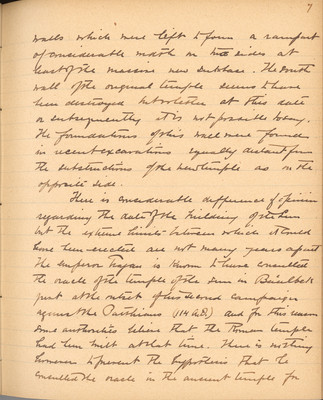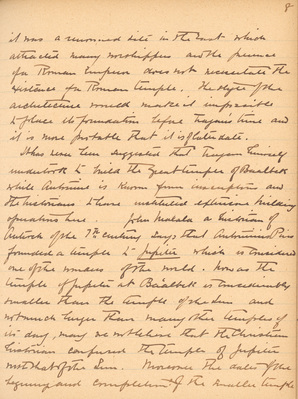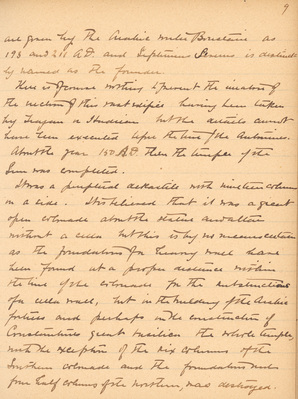Pages
BSY_FB_03-05
5 Phoenician mode of construction. In northern Syria we find this style applied to every kind of building - in temples of classic style, in churches, in private houses, of all periods from the early years after Christian Era down to the first Mohammedan invation (636).
The building operations carried on by the Romans in other parts of the world, the churches erected under the Byzantine emperors in Europe and Asia Minor did not partake of this Megalithic character which only the successors of the Phoenicians seem to have understood. The walls at Ba'albek are of course the example par excellence of this style. The question of the method by which the great blocks were moved has long lain unsolved but the recent discovery in the Haorman?, of a huge machine in fragments is expected to throw some light upon the problem.
BSY_FB_03-06
6 The Emperial Roman Period Temple of the Sun
It was in the second century of our era that the Roman Emperors - spreading their domain toward the East, found in Ba'albek a formidable opportunity for the display of Roman greatness in the rebuilding of one of the most ancient and famous of religious sites in the East.
Antoninus Pius, whose enthusiasm for the revival of paganism raised temples to the gods in all parts of the Roman world, was the first Emperor to set the seal of imperial form upon the shrine of the Sun god by the erection of a temple.
Whether the Phoenician temple was at this time in ruins or not we cannot know but the new temple, the most gigantic ever erected by the Romans, was built within the outer wall sof the older structure and was raised upon stupendous substructures well above the lower ocurses of the Megalithic
BSY_FB_03-07
7 walls which were left to form a rampart of considerable width on two sides at least of the massive new sub-base?. The south wall of the original temple seems to have been destroyed but whether at this date or subsequently it is not possible to say. The foundations of this wall were found in recent excavations equally distant from the substructures of the new temple as on the opposite side.
There is considerable difference of opinion regarding the date of the building of the Sun? but the extreme limits between which it could have been erected are not many years apart. The emperor Trajan is known to have consulted the oracle of the temple of the Sun in Ba'albek just at the outset of his second campaign against the Parthians (114 A.D.) and for this reason some authorities believe that the Roman temple had been built at that time. There is nothing however to prevent the hypothesis that he consulted the oracle in the ancient temple for
BSY_FB_03-08
8 it was a renowned site in the East which attracted many worshippers and the presence of a Roman Emperor does not necessitate the existence of a Roman temple. The style of the architecture would make it impossible to place its foundations before Trajan's time and it is more probably that it is of later date.
It has been suggested that Trajan himself undertook to build the Great Temple of Ba'albek while Antoninus is known from inscriptions and the historians to have instructed extensive building operations here. John Malala a historian of Antioch of the 7th century says that Antoninus Pius founded a temple of Jupiter which is considered one of the wonders of the world. Now as the temple of Jupiter at Ba'albek is considerably smaller than the temple of the Sun and not much larger than many other temples of its day, may we not believe that the Christian historian confused the temple of Jupiter with that of the Sun. Moreover the dates of the beginning and completion of the smaller temple
BSY_FB_03-09
9 are given by the Arabic writer Brustani? as 193 and 211 A.D. and Septimius Severus is distinctly named as the founder.
There is of course nothing to prevent the initiation of the erection of this vast edifice having been taken by Trajan or Hadrian but the details cannot have been executed before the time of the Antonines. About the year 150 A.D. then the temple of the Sun was completed.
It was a penpteral dekastile with nineteen columns in a side. It is believed that it was a great open colonade about the statue and altar without a cella but this is by no means certain as the foundations of a heavy wall have been found at a proper distance within the line of the colonade for the substructions of a cella wall, but in the building of the Arabic fortress and perhaps in the construction of Constantinus great basilica. The whole temple, with the exception of the six columns of the southern colonade and the foundation ? from half columns of the northern, was destroyed.





